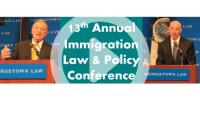Asylum Seekers
Recent Activity

In the year since the Valletta Summit, the European Union and Member State governments have ramped up cooperation with origin, transit, and hosting countries, yet questions remain over how effective these partnerships have been and how far they can be reasonably be pursued. This webinar is a discussion on longer-term interventions the European Union may pursue to find solutions for asylum seekers, including cooperation with other countries on migration management.

Marking the release of All at Sea: The Policy Challenges of Rescue, Interception, and Long-Term Response to Maritime Migration, this book discussion explores the different facets of maritime migration and the challenges governments, civil society, the private sector, and international organizations face in tackling this issue together. Presenters discuss the overwhelming Mediterranean crisis and movements across the Bay of Bengal/Andaman Sea, the Red Sea/Gulf of Aden, in the Caribbean, and the waters around Australia; and the particular challenges for policymakers in each of these cases.

One month ago, world leaders gathered at the United Nations for a summit to discuss movements of refugees and migrants, however the absence of concrete commitments in the resulting New York Declaration disappointed many observers and the slow progress on multilateral cooperation around migration has particular salience for the European Union, since the arrival of more than 1 million asylum seekers to Europe in 2015. This panel brings officials together from a range of institutions mandated to consider the future of cooperation, whether bilaterally, regionally, or at the global level, and asks: What is possible, what is desirable, and what is likely?

MPI experts discuss outcomes from the UN Summit for Refugees and Migrants, the Leaders Summit on Refugees, and related private-sector meetings and how these efforts may gain momentum to change international responses to the complex threats refugees and migrants face.

The 13th annual Immigration Law & Policy Conference offered policy and legal analysis on key immigration topics, including: the election and the future of immigration policy; refugee resettlement in the United States; immigration detention and enforcement; and the impacts of the Supreme Court opinion in the important U.S. vs Texas case
Pages
Recent Activity
People on all sides of the policy debate largely agree that the U.S. immigration system is broken. What should a 21st century system that works in the national interest look like? And is this vision achievable amid current political realities? In this World of Migration podcast episode, MPI Senior Fellow Doris Meissner speaks with Policy Analyst Ariel Ruiz Soto about how to build an immigration system that reflects today’s realities and builds in the flexibility to adapt to future developments.
La cantidad de migrantes africanos que viajan por América del Sur y Central con la esperanza de llegar a la frontera entre Estados Unidos y México para buscar asilo es pequeña, pero está aumentando. Este informe examina los factores que impulsan la migración africana a través de las Américas, las rutas y los desafíos comunes, y las respuestas de países de tránsito en América Latina.
This virtual conference explores how the diverse landscape of partnerships, social enterprises, participatory models, and community-led initiatives spearheading social innovation for inclusion has fared during COVID-19. It also focuses on how this ecosystem can emerge strengthened from the pandemic, and be a vital force in addressing new humanitarian challenges.






















It Is Too Simple to Call 2021 a Record Year for Migration at the U.S.-Mexico Border